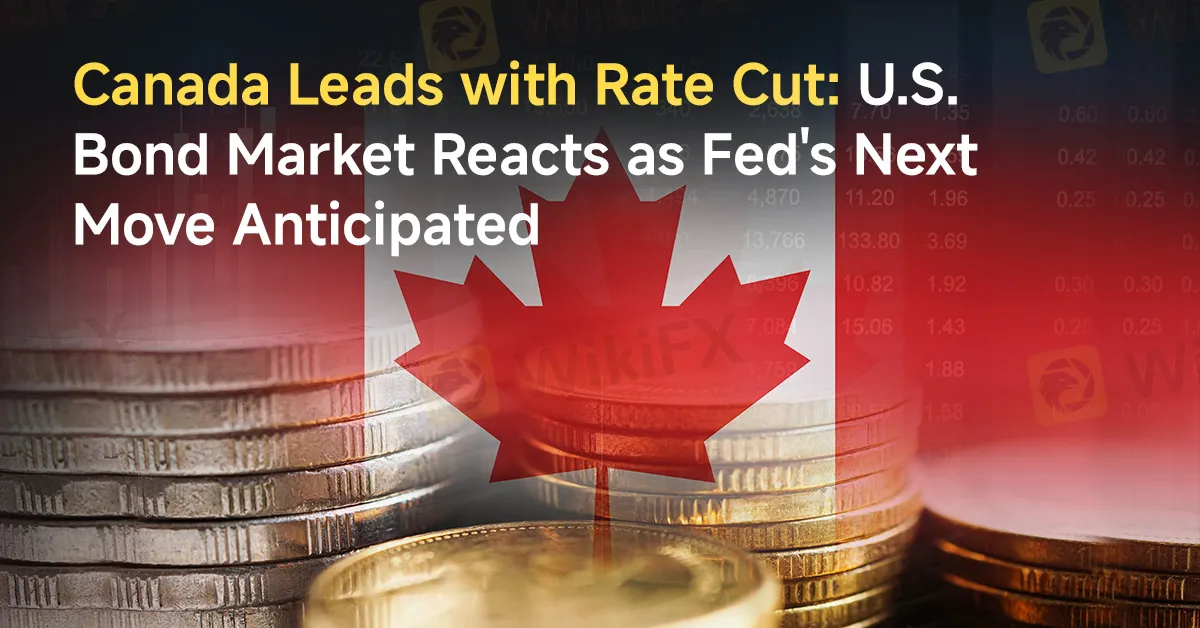简体中文
繁體中文
English
Pусский
日本語
ภาษาไทย
Tiếng Việt
Bahasa Indonesia
Español
हिन्दी
Filippiiniläinen
Français
Deutsch
Português
Türkçe
한국어
العربية
Canada Leads with Rate Cut: U.S. Bond Market Reacts as Fed's Next Move Anticipated
Abstract:According to Bloomberg, in a decisive move, the Bank of Canada (BoC) has reduced its key interest rate by 25 basis points to 4.50%, marking the first rate cut among G7 nations and widening the policy rate gap with the Federal Reserve to its largest since 2007. This move signals potential further easing, intensifying speculation around the Federal Reserve's upcoming decisions. ING anticipates a Fed rate cut in September, but the volatile U.S. bond market suggests a potential move as soon as next week.

According to Bloomberg, in a decisive move, the Bank of Canada (BoC) has reduced its key interest rate by 25 basis points to 4.50%, marking the first rate cut among G7 nations and widening the policy rate gap with the Federal Reserve to its largest since 2007. This move signals potential further easing, intensifying speculation around the Federal Reserve's upcoming decisions. ING anticipates a Fed rate cut in September, but the volatile U.S. bond market suggests a potential move as soon as next week.
BoCs Doveish Stance
BoC Governor Tiff Macklem's statements and press conference remarks bolstered dovish expectations following the rate cut. Emphasizing the downside risks to the economy, Macklem stated, “We need economic growth to rebound so that inflation doesnt fall too much, even as we strive to bring inflation down to our 2% target.” While ING considers this a moderate view, the BoC's new quarterly forecast reflects cautious optimism, projecting overall and core inflation to hit 2.0% by the end of next year, with GDP growth forecasts adjusted downward to 1.2% for 2024 and 2.1% for 2025.
Interest Rate Differential Concerns
Analysts highlight concerns over the widening interest rate differential between the BoC and the Fed, currently at -100 basis points. This is the most significant negative differential since 2007, and should the BoC cut rates again before the Fed, it would create the largest gap in 25 years. However, the BoCs primary concern does not appear to be this differential.
Currency Implications
There are worries about the Canadian dollar (CAD) depreciating excessively against the U.S. dollar (USD) due to divergent central bank policies. ING notes, “We must acknowledge that the BoC‘s latest statement and monetary policy report did not address forex-related inflation risks. Notably, since the BoC’s rate cut in mid-July, the USD/CAD has risen by just 1.2%, less than other G10 currency pairs. As long as USD/CAD remains around 1.38 or higher, concerns over excessive currency depreciation should be minimal.”
Market Expectations and Future Moves
Despite the current dovish outlook, market expectations for the BoCs September 4 meeting are at -15 basis points, possibly due to the timing being two weeks before the Fed's meeting. Post rate cut, year-end expectations have hovered around -45 basis points.
ING aligns with market forecasts, predicting the BoC to pause in September, followed by 25 basis point cuts in October and December. Macklems dovish comments suggest a higher likelihood of a September cut, heavily dependent on inflation trends and economic health. “Macklem seems to have shifted focus from inflation to growth, indicating a potential September cut,” ING remarks.
Fed's Influence and Potential Rate Cut
The Fed's policy will significantly influence market expectations. If the market prices are in a September Fed rate cut, it may partially expect a BoC cut in the same month. ING's base case predicts the Fed cutting rates in September, possibly leading the BoC to cut rates two weeks earlier. This could increase the likelihood of additional cuts by the BoC before year-end.
Impact on CAD
The CAD has shown resilience despite the BoC's rate cut, reflecting the move in prices. Recently, the CAD has outperformed the AUD, NZD, NOK, and SEK. This trend may continue in the short term due to reduced risks from the new Trump administration compared to other high-beta G10 currencies, and better liquidity in the CAD, making it more resistant to risk-off sentiment.
However, the widening USD/CAD interest rate differential suggests continued upward pressure on the currency pair. ING forecasts a potential break above 1.380 and an extension towards 1.390 if the market fully prices in a September BoC cut. A Fed policy easing could trigger a USD/CAD pullback in the short term. “We still hold a medium-term bullish view, expecting USD/CAD to fall below 1.350.”
Conclusion
Former New York Fed President William Dudleys recent call for the Fed to cut rates next week to counter recession fears has added fuel to the speculation. This marks a significant shift from his long-held view that the Fed would maintain high rates for an extended period.

Disclaimer:
The views in this article only represent the author's personal views, and do not constitute investment advice on this platform. This platform does not guarantee the accuracy, completeness and timeliness of the information in the article, and will not be liable for any loss caused by the use of or reliance on the information in the article.
Read more

Is Amillex Safe or a Scam? Understanding Rules and Security
You are asking an important question: Is Amillex safe or a scam? The simple answer is that Amillex works in an unclear area that needs careful study. It is not a complete scam like fake websites that steal your money right away, but it also does not meet the safety rules of the best, well-regulated brokers. Read on to explore more details.

Voices of the Golden Insight Award Jury | David Bily, Founder and CEO of Moneta Markets
WikiFX Golden Insight Award uniting industry forces to build a safe and healthy forex ecosystem, driving industry innovation and sustainable development, launches a new feature series — “Voices of the Golden Insight Awards Jury.” Through in-depth conversations with distinguished judges, this series explores the evolving landscape of the forex industry and the shared mission to promote innovation, ethics, and sustainability.

ASIC Launches Preliminary Investigation into Clime Australian Income Fund
The Australian Securities and Investments Commission (ASIC) has launched a preliminary investigation into the Clime Australian Income Fund, examining whether the Fund’s Target Market Determination (TMD) and Product Disclosure Statement (PDS) comply with Australian financial regulations. The investigation will also assess whether any breaches of the law have occurred in relation to the Fund’s investment activities.

HSBC announced a $1.1 billion charge linked to the largest Ponzi scheme in financial history
The British banking giant HSBC Holdings Plc has announced a potential $1.1 billion charge connected to the long-running Bernard Madoff Ponzi scheme, following a legal ruling in Luxembourg. The claim stems from Herald Fund, a European investment fund that sued HSBC over alleged losses related to the Madoff fraud.
WikiFX Broker
Latest News
Is Nash Markets Regulated or Risk? Truth About Nash Markets’ License & Withdrawal Issues
Webull Widens Crypto Futures with Coinbase Derivatives
Latest FCA Daily Alerts and Consumer Warnings for 2025
CySEC Blocks Certification Access to Combat Advisor Impersonation
Angel one 2025 Review & Complaints
Exclusive Markets Under the Scanner: Traders Report High Swap Charges, Deposit Discrepancies & More
Interactive Brokers Fined for FINRA Market Data Lapses
Annual Sales Of New Vehicles Expected To Hit Only 15.7 Million Units: Cox
Amillex Broker Affiliate Program: A Complete Guide to Earning with Referrals
Saxo Bank Japan Expands European Stock Portfolio with UBS, Ferrari, and Other Major Names
Currency Calculator



